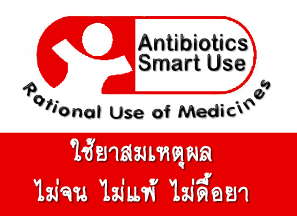In 2007, an innovative program to promote the rational use of antibiotics and curb antibiotic resistance was launched in Thailand: Antibiotics Smart Use.
Aim of Antibiotics Smart Use
The Antibiotics Smart Use (ASU) program in Thailand is an innovative way to promote the rational use of antibiotics by strengthening human resources, improving health facility infrastructure, and empowering communities in a setting with limited resources. The project targeted three conditions not requiring antibiotic treatment: upper respiratory infections, especially the common cold with sore throat, acute diarrhea and simple wounds. For these conditions ASU attempted to reduce unnecessary use of antibiotics.
Implementation in three phases
The ASU program is an implementation research project comprised of three phases (see also Table 1):
- Implementation of behavior change interventions;
- Examination of the feasibility of scale up; and
- Identification of mechanisms for sustainability
In the beginning, ASU consisted of a network of researchers from Thailand’s Ministry of Public Health and pharmacists and doctors from Srinakharinwirot University and Chulalongkorn University. In phase 1 (2007- 2008), they piloted educational and training reforms to improve prescribing in 10 hospitals and 87 primary health centers in one province. Antibiotic prescription, provider attitudes of effectiveness and knowledge of antibiotics, non-prescription rates in case of non-bacterial infections, and patient health and satisfaction were monitored.
In phase 2 (2008-2009), the same indicators were then used to scale up the program to three provinces and two hospital networks, counting to 44 hospitals and 621 primary health care centres.
The 3rd phase (2010 – Present) focused on long-term sustainability and scale up of ASU – initially to 22 hospital networks in 15 provinces, and then subsequently across the entire country.
Table 1. Characteristics of the ASU program, by programmatic phase.
| Characteristics | Phase 1 (1 year) |
Phase 2 (1 year, 3 months) |
Phase 3, transition period |
| Goals | Test effectiveness of ASU in changing antibiotic prescription behavior | Test feasibility of scaling up ASU model | Strengthen networks, assess scaling up mechanisms |
| Target | 1 province | 3 provinces and 2 networks of public and private hospitals | 22 hospital networks in 15 provinces |
| Funding agencies |
WHO, Thai FDA | HSRI, NHSO, Thai FDA | DSMDC, Thai FDA |
| Coordinating agencies |
Thai FDA | Thai FDA | DSMDC, Thai FDA, IHPP |
| Budget spending | US$ 33,000 | US$ 73,000 | US$ 123,000 |
| Spillover effect | No | Yes | Yes |
Adapted from Sumpradit N, Chongtrakul P, Anuwong K, et al., 2012
Since its inception, the ASU program has been highlighted as a best practice example of how to curb inappropriate use of antibiotics and limit growing antibiotic resistance in the both hospital and community settings.
Keys for success
Key reasons for the success of ASU, according to project managers, was the championing of the concept at different levels, from community to the national health system. Thanks to this for example in 2009, ASU was first adopted into the Thai healthcare system’s Pay-for-Performance (P4P policy), a major achievement as there was stiff competition from other health priorities vying for the same status. An antibiotic resistance research program from Bangkok’s Siriraj Hospital provided significant, domestic evidence for Thailand that the rate of antibiotic use for upper respiratory infections, acute diarrhea and simple wounds should not exceed 20%. This figure was adopted by the P4P policy for ASU implementation.
The participation of numerous partner organizations in bringing about change in practices and social norms regarding antibiotics in the field also played an important role in spreading the ASU initiative and providing ground-level evidence of its impact.
For example, since 2008 the ASU‐Muaklek Project by the Langkhhao primary health center, Muaklek District, Saraburi Province has carried out intensive community education campaigns targeting reduction in antibiotic use. The community is now a model for others in Thailand to visit and learn about different popular communication and mobilization tools for educating the general public on dangers of antibiotic overuse.
Similarly, inspired by the ASU concept, in 2013, the Queen Sirikit National Institute of Child Health (the largest children hospital in Thailand), launched the Antibiotic Smart Use in Children (ASU‐Kids) Project to reduce unnecessary antibiotic prescriptions for upper respiratory infections, acute diarrhea and simple wound in children and to empower parents to provide proper care to their kids. The project was launched as a key feature of the Antibiotic Awareness Day 2014.
Integration into national program
The Antibiotic Smart Use program became part of the overall Antimicrobial Resistance Containment Program 2012-2016 in Thailand and its concepts and messages are part of the country’s National Strategic Plan on Antimicrobial Resistance (2017-2021). In 2016, the Thai Ministry of Public Health (MOPH) integrated the ASU concept and its key messages as part of its Rational Drug Use policy package, thus making it a nation-wide program.
Selected Resources
| Resource | Description |
| Antibiotic Smart Use – A case study (PDF, 4MB) | Case study. A write up from ReAct about the Antibiotics Smart Use program. |
| Antibiotics Smart Use: a workable model for promoting the rational use of medicines in Thailand | Journal article in the WHO Bulletin highlighting the Antibiotics Smart Use program. |
| Antibiotics Smart Use Program: Thailand’s experiences in promoting rational use of antibiotics (PDF) | Slideshow. A presentation describing the ASU program. |
| Putting Theory into Practice: Lessons learned from Antibiotics Smart Use Program | Slideshow. A PowerPoint presentation about the lessons learned from the ASU program. |

